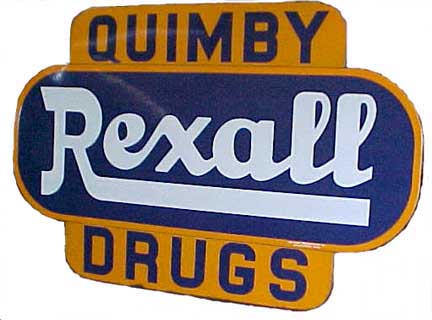
Drug Store Appliances
Forever Brand X
Fostoria Ohio
The term "Drug Store Appliances" refers to low-quality, cheaply made versions of toasters, fans, mixers, and the like that were mass-marketed by chain stores. The history of these items centers in one small midwestern town. So, let us now speed off to Fostoria, Ohio.
Fostoria is located in Northwest Ohio approximately 40 miles southeast of Toledo. Columbus, Cleveland and Detroit are all within two hours travel. In the 1930s, Fostoria was a major rail junction for a number of major carriers, providing excellent opportunities for national distribution of manufactured products. Because of this, industry was fairly well established, although no products of national priminence were manufactured there. The one "quality" company that bears the Fostoria name is located somewhere else, an interesting story in its own right.
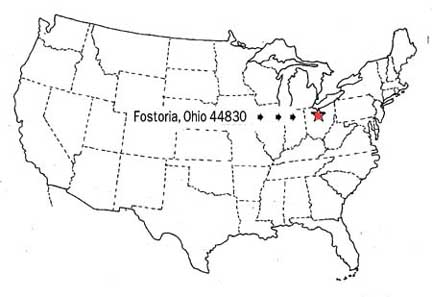
Fostoria, Ohio
Very Convenient to Cleveland
A Brief Diversion to the Fostoria Glass Company
The Fostoria Glass Company began as a glass-producing house in 1887. It was initially located in Fostoria, Ohio, because a large natural gas field had been "discovered", supposedly providing a cheap source of heat for the furnaces. Although the townspeople of Fostoria, Ohio had given their land to the glass company for free, Fostoria Glassworks was unable to remain because the gas field proved to be nonexistent. The promise of more abundant resources for producing glass caused the company’s leaders to move to Moundsville, WV. In 1891, the company built one furnace capable of firing 14 pieces, a remarkable achievement for the late 19th century glassworks industry. This furnace continued to produce glass until 1972,and Fostoria is known for a very large number of collectible glass lines.
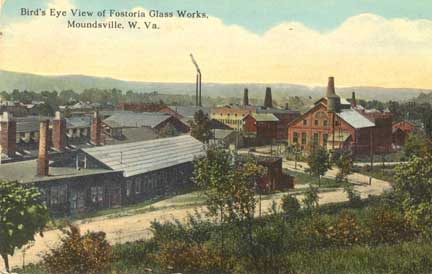
The Fostoria Glass Factory
In Moundsville after an "Oops"
However, the legacy of this incident is that Fostoria went on the map as a target for sharp operators...
Enter Al Bersted
Albert Bersted is one of the most famous and notorious "wheeler-dealers" in the crazy world of consumer appliances. He was a talented engineer and a financial manipulator who formed companies, sold them, then bought them back and created conglomerations with dizzying speed. He began in Chicago with a small outfit that made resistance heat appliances (toasters, hot plates, hair dryers and the like.) Here is an example of one of the Chicago factory's products. It is not very appealing.
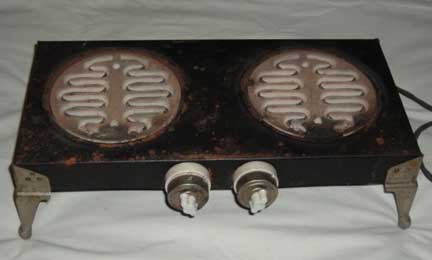
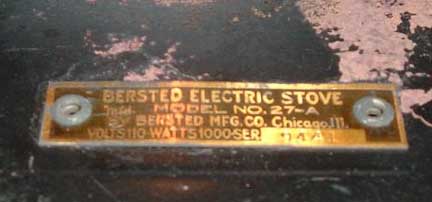
The Bersted (Chicago) Hot Plate
"Chicago" Name Plates for Bersted Appliances Are Rare
This was a particularly good time to be in this business because the "pop-up" toaster was all the rage in 1926 -- it was sort of like plasma screen TVs in 2004 -- trendy people just had to have one, and they would pay $30 for it when the average man would work all day for less that $2. ($30 in 1925 is equivalent to $900 in 2005!). The McGraw Electric Company was in the business of generating electricity AND selling appliances -- given the vast sums to be made, they bought everything in sight that even looked like it might be capable of making toasters. Thus, in 1926, Al Bersted sold his Chicago company to McGraw Electric, making his first major score.
Skipping ahead to 1934, the Big Story in Fostoria was an announcement in the Gazette that "...the Bersted Electrical Manufacturing Co. of Chicago, makers of the well-known and popular 'Bersted' brand of household appliances, would be moving to town early in April. The new industry will be housed in the former Evans Lead Co. plant and an additional building is to be erected immediately. This is expected to lead to the employment of 150 to 200 Fostorians..." There was no mention that Bersted manufacturing had been totally absorbed in McGraw.
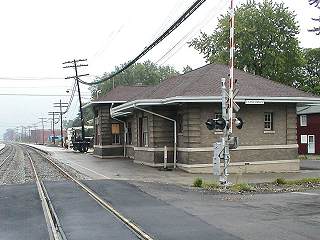
The Fostoria Train Station
Big Al and "Cookie" got off Here
Company president Al Bersted and his secretary arrived in Fostoria on Jan. 24 to sign agreements between the firm and the Fostoria Industrial Corporation, the town's Booster Club. The Bersted Corporation was, in fact, just Al and his "secretary." Thus began an amazing saga of cut-rate appliance manufacture.
In fact, Al Bersted was a genius -- a peculiar kind of genius, but a genius nonetheless. He had the ability to take an appliance apart -- any appliance, mind you -- and figure out how to manufacture it cheaply. In general, Bersted's creations were "cheap and cheesy" -- chrome plating was thin, wood was used instead of Bakelite, heating wires would be an inch apart instead of a quarter inch. Al had his eyes on the vast market -- the millions of average Americans with $2-$5 to spend on an appliance. Al's creations are not in museums and most of them were junk six months after they were purchased, but he made money. Lots of it.
Al had accomplices in his plans -- namely the big chain stores that were sweeping the country. Of note, the first mass-market "discounters" were Drug Stores. In order to use their facilities when people were "healthy" as well as "sick", Drug Stores started offering both food service and a line of consumer goods, particularly appliances. This was especially relevant since most pharmacies were allowed to be open Late and on Sundays. The fact that drug stores also sold "medicinal alcohol" during Prohibition was another draw... [pharmacies that have survived intact from this period have a curious "back room" where local dignitaries could take their "prescription" -- a.k.a. a "short snort"]. Al Bersted made an alliance with the Rexall Chain and later Walgreens. History has memorialized Bersted's products as "Drug Store Appliances."
During the period 1935-1941, Bersted used his profits to acquire United Electrical Manufacturing Company, Adrian, Michigan, ("Eskimo" fans); Swartzbaugh Manufacturing Company, Toledo, ("Everhot" appliances);the "Tip-Toe" iron from Yale & Towne Manufacturing Company; and Edison of Canada Limited. During the war years, Bersted was able to acquire materials and keep the flow of goods running strong when his competitors could not.
Other companies did not fare so well. In 1941, Bersted acquired his "Crown Jewel" -- Manning-Bowman & Company, Meriden, Connecticut -- largely because M-B could not obtain the chrome that was key to its ultra-high quality products. The Manning-Bowman Company was considered to be the "Cadillac" of marks, making products which found their way into the homes of the very wealthy and to those more humble homes of the middle class who aspired to higher station. Whether is was a butler, maid, or homemaker who served guests in ware made by Manning-Bowman, the items were always well-designed and seemed to last forever. (This of course can be a problem if you are trying to sell large volumes of consumer goods, year-in and year-out. ) Nevertheless, authentic Manning-Bowman products, especially those with the "M-B Means Best" logo are among the most prized deco artifacts.
Most of the well-known appliances designs for which the Manning-Bowman company were known before war now were moved to Fostoria for "re-use" with planned obsolescence in mind. The post-war period proved a difficult one for what was left of M-B. Since Bersted used designs that had not changed much from the Art Deco period, they met with limited acceptance by trendy sophisticates. What was left was the Drugstore market. By 1951, no appliances were made with the (now) thoroughly devalued Manning-Bowman name. Our poor little drugstore grill (below) is yet more evidence of the effect of corporate shennanigans on quality. You will see this theme repeated throughout these pages. Corporate takeovers result in low quality products and eventually the public catches on!
Click Here for a more detailed discussion of Manning-Bowman designs to contrast them with the drugstore artifacts shown below.
Nobody has ever gone broke underestimating American taste. In 1948,McGraw Electric re-purchased the Bersted Manufacturing Company and Al started off to make another fortune... again and again.
Bersted products are made of low quality materials, they do not perform their function well, and they break down quickly. As such, they have little intrinsic value -- you can't really use them (as we use our up-scale appliances) on a daily basis. However, since they are relatively rare, they are of some interest to the collector . However, they are "rare" because they broke down almost immediately.
As you will see in the next series of photos, a surprising number of Bersted appliances from the 1920s, 1930s, and 1940s have been "found" in new, unused condition, very often with the original boxes and cord tags!
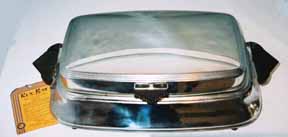
Drugstore Sandwich Grill
We got very lucky at an estate sale -- we found a box in an attic with a large number of appliances that had NEVER BEEN USED! The house had been owned by people who obviously knew quality. Our guess is that these unused items were gifts of one sort or another, sort of like those fruitcakes, wine chillers, or exotic tea assortments that come from distant but well-meaning business associates. There is nothing actually wrong with them, but they get put in the back of the closet and forgotten. We were particularly impressed with this "REX-RAY" sandwich grill that had been purchased in a Rexall Drugstore. This is a copy of a Manning-Bowman appliance, but in every respect, it is lighter, less flexible and more cheaply made.
As is quite ususal for Bersted Appliances, this one has its original sales tag still attached. The tag says that this is the "Rex-Ray Grill and Sandwich Toaster Model X126" --- in fact, this is a Fostoria Sandwich Grill made by the Bersted Manufacturing Company of Fostoria, Ohio. It is their Model 350, and draws 500 Watts at 115 Volts. We note that the Rexall guarantee requires you to return the object to the "Rex Ray Service Station" (no street address given...) in of all places, Fostoria, Ohio. This object cost $7.25 at your local Rexall Pharmacy in the mid 1940s.
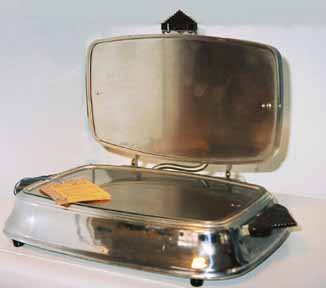
Here's what's on the attached Tag:
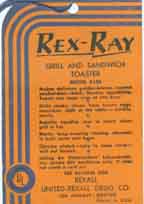

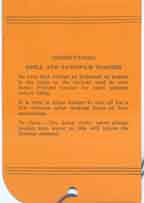
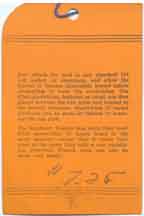
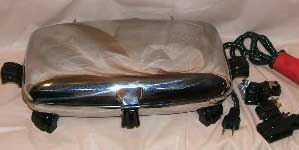
Here's Another Sandwich Grill, Found New and Unused
On our Fan Page, we discuss the so-called "Drugstore Fans" that are collectible because not many of them survived the test of time... So it is for other electrical appliances. Bersted made both the "Zero" fan and the "Eskimo" fan, brand-names that would suggest their cooling power...
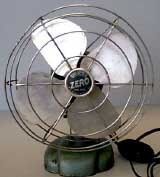
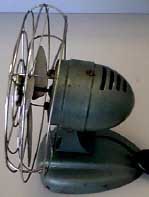
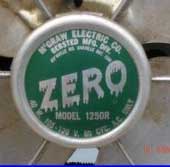
"ZERO" Drug Store Fan
Cheap but Clever
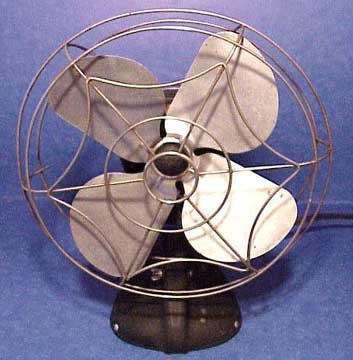
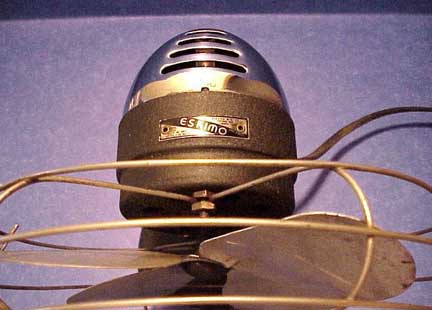
Nondescript "Eskimo" fan
Bersted also made a "hassock" model that sat on the floor and circulated air. Here is a photo of the Cheesy Bersted fan (left) and a high-quality "Freshnd Aire" fan (right) -- the difference is readily apparent.
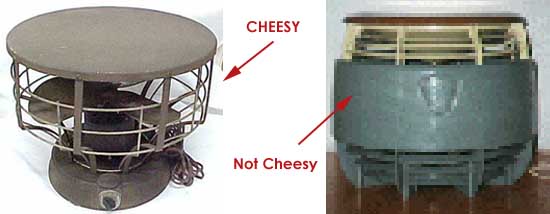
Don't get too close to the Bersted fan....
Often, a mediocre "Drug Store Fan" can often fetch much higher prices than quality fans. I particularly like the first one because the letters in the word "ZERO" appears to be made of melting ice. The "Eskimo" is strictly "blah."
What is a "fan" but a motor, a shaft and a propellor. Here is Big Al's clever repackaging of a fan as a kitchen mixer or blender:
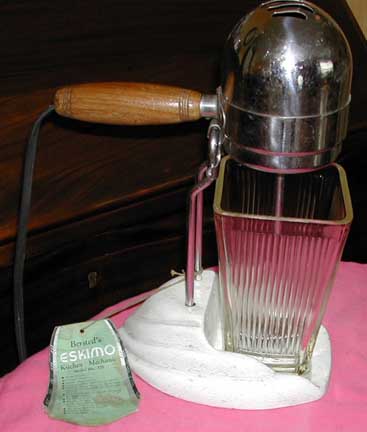
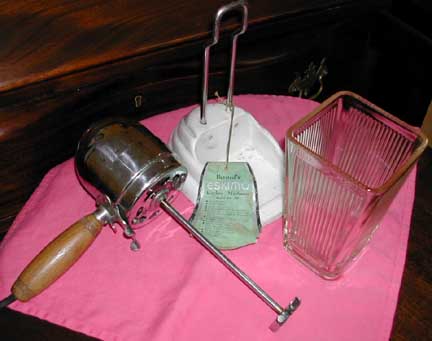
The "Eskimo" Blender
It is hard not to see a "fan" in this appliance! Notice that it still has the original cord tag.
And, thanks to our friend, Dick, we have photos of a Bersted Mixer that really shows the "fan" influence:

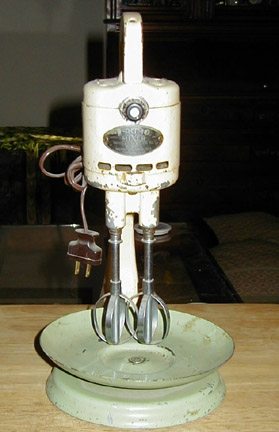
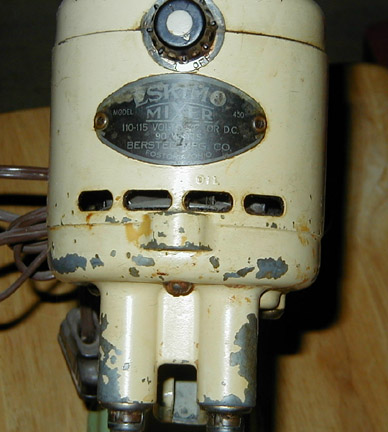
The "Eskimo" Mixer
Dick writes:
"... I have a Bersted Food Mixer which was not pictured in your article. The metal label identifies it as an "Eskimo Mixer Model 450 Bersted Mfg. Co. Fostoria, Ohio" It has a wooden handle. The mixer head could swivel in for a small mixing bowl and out for a large one. As you can see, this one got lots of use. It belonged to my late wife's grandmother. I have recently donated it to the Sparks Heritage Museum, Sparks, NV. ..."
After the mixer, it is not too far a step to envision the vibrator. In fact, it looks like Bersted knocked off the vibrator that was patented by A. C. Gilbert, the guy who gave us the Erector Set.
The Eskimo Vibrator
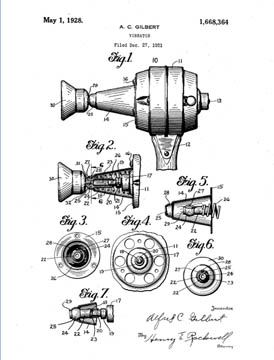
Patent for a "Vibrator"
Click Photo to Enlarge It
Check out our Web Page on Erector Sets
We want to thank our friend Jim for sending us these photos -- note that the Eskimo Vibrator is new in its original box. Jim, tells us that he found it in his attic, untouched these many years.
A Hair Dryer is just like a "fan" except that you put some resistance wires across the outlet to generate heat. Voilla! The Eskimo Hair dryer:
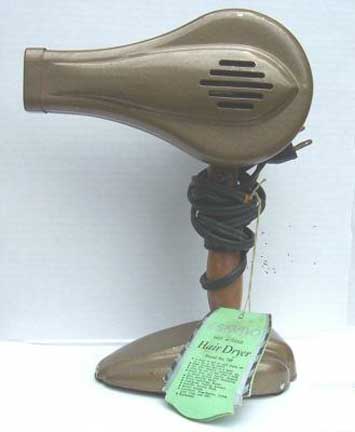
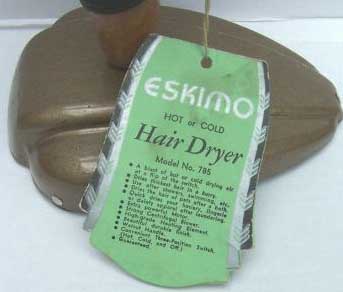
The "Eskimo" Hair Dryer
New With the Original Cord Tag
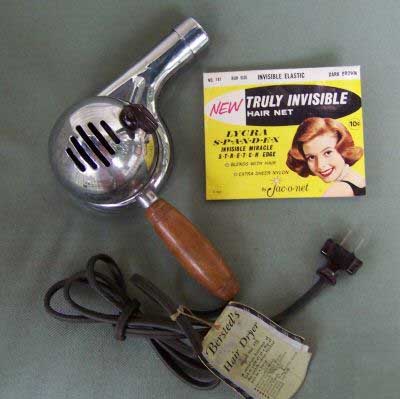
Another "Bersted" Hair Dryer
Yep, New With the Original Cord Tag
Compare this with some of the quality hair dryers shown on our Miscellania Page.
And, what is a knife sharpener but a motor shaft and a grindstone instead of a propellor...

The "Eskimo" Knife Sharpener
New With the Original Cord Tag
Finally, here are some pictures of Bersted's low-budget clones of other appliances:
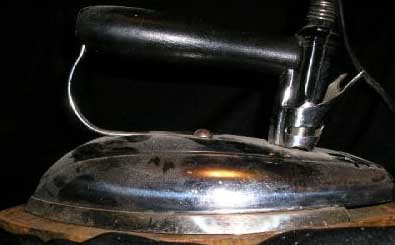
"Tip-Toe" Iron
From the Remnants of Yale & Towne Manufacturing Company
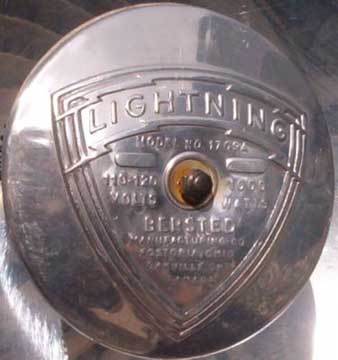
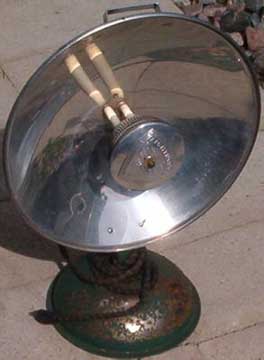
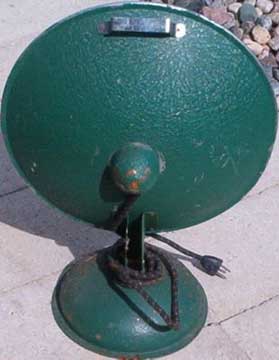
"Lightning" Heat lamp
From the Remnants of Edison of Canada
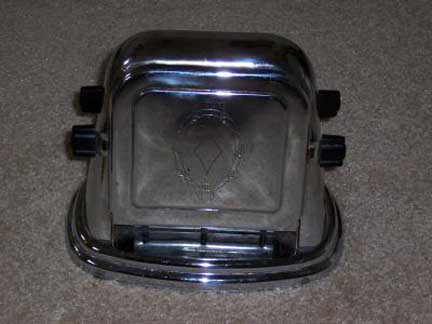
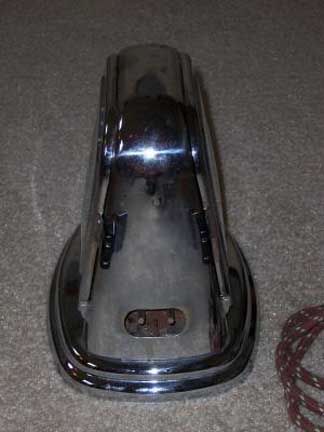
"Everhot" Toaster
From the Remnants of the Swartzbaugh Manufacturing Company, Toledo
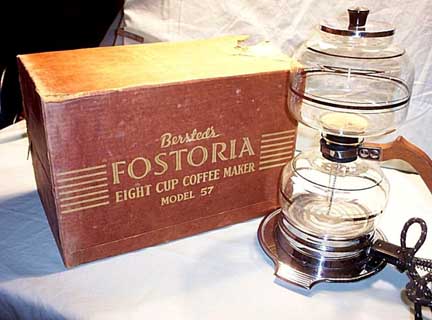
The Fostoria Vacuum Coffee Brewer
New With the Original Box
You might want to check out our page on Vacuum Coffee Brewers to contrast the last item with some quality pieces -- the cheesy wood handle is a dead giveaway!
Here is a waffle iron based on the classic Manning-Bowman design with an inset thermometer. Notice that the Bakelite handles are very thin. Contrast this with our photoessay on the magnificent Manning-Bowman Twin-o-Matic.
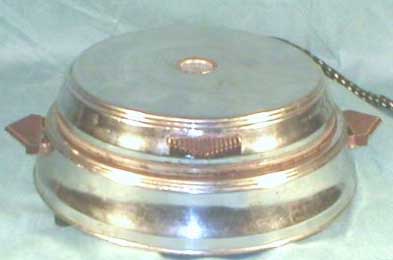
The Bersted Waffle Iron
A Pale Imitation of the Manning-Bowman Waffle Iron
Here is a gadget that could be used for popping corn or roasting coffee beans. This may be from the 1926 Chicago incarnation of the Bersted Company. The resistance heat is supplied in the chrome base. A metal bowl with a hinged glass lid fits into the base. A knob at the top allows the user to spin a metal agitator inside the heated bowl to mix whatever was inside. This is only about 8 inches on a side and one could not pop a whole lot of corn in it; my guess is that it was primarily intended to roast coffee or nuts.
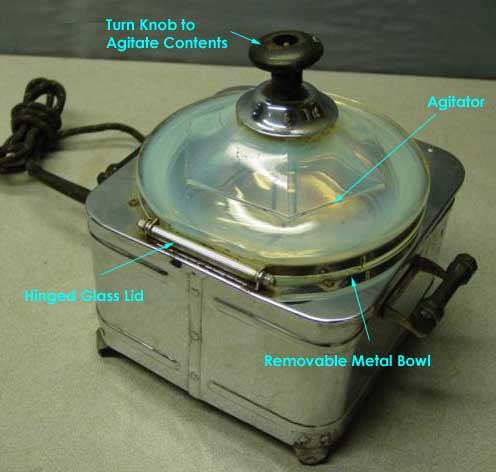
The Bersted Coffee Roaster
Probably from the Chicago Factory
Here is another knock-off, drug store type appliance found in an attic (new and untouched) by our friend Jim -- it is supposed to be a shoe polisher, although it owes much of its heritage to Mr. Bersted's fan/mixer/vibrator...
The Valiant Shoe Polisher
From the Morris-Struhl Company, new in the box...
The moral of this: If you shop at Wal-Mart, your purchases aren't likely to be treated well by historians!
Counter for the Entire Site (not just this page..)
Home | About Lindy | 1940s Collectibles | Upcoming Events | Vintage Clothing
The Guide - Establishments - Travel - Accessories
Music | Links | Photo Gallery | Extras | Contact